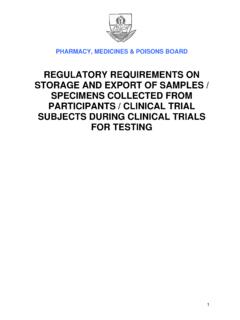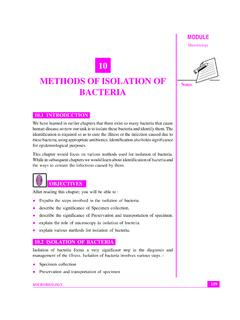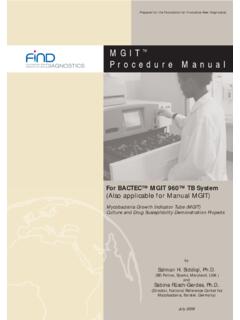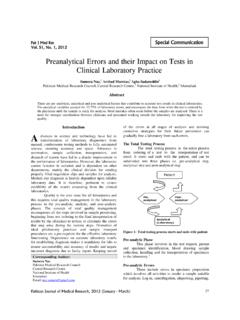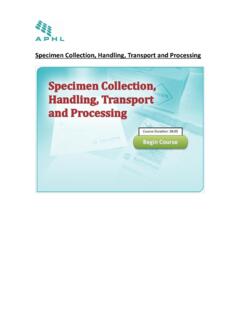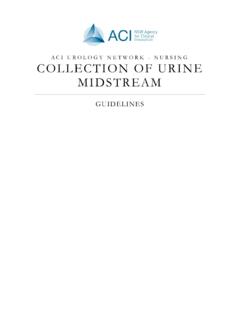Transcription of Unit 42: Obtaining and Testing Specimens from Individuals
1 Unit 42: Obtaining and Testing Specimens from Individuals Unit reference number: L/616/7118. Level: 2. Unit type: Optional Credit value: 2. Guided learning hours: 15. Unit summary Obtaining and Testing Specimens is an important role performed by a variety of workers in the care sector. It is necessary to understand the processes involved when Obtaining and Testing a variety of Specimens , including using the correct equipment and materials, and the hazards associated with incorrect labelling. Understanding how to ensure appropriate and safe practice when carrying out this role is crucial. In this unit, you will gain the knowledge and skills needed to be able to obtain and test Specimens from Individuals . You will gain an understanding of the legislation, national guidelines and organisational policies relevant to the practice of Obtaining , transporting, Testing and storing Specimens . This unit will enable you to prepare and carry out Obtaining and Testing of Specimens from Individuals using the correct process, demonstrating the appropriate and correct actions, including safety at all times.
2 As defined by the assessment strategy, centres should ensure that assessors assessing this unit are technically competent and possess the relevant occupational knowledge. The assessment strategy can be found in Annexe A of the associated qualification specification. 978 1 446 95316 7 Pearson BTEC Level 2 Diploma in Care (England) 1. Unit Issue 1 January 2018 Pearson Education Limited 2018. Learning outcomes and assessment criteria To pass this unit, the learner needs to demonstrate that they can meet all the learning outcomes for the unit. The assessment criteria outline the requirements the learner is expected to meet to achieve the unit. Learning outcomes Assessment criteria 1 Understand relevant legislation, Outline current legislation, policy and good practice in national guidelines, organisational relation to Obtaining , carrying, policies and protocols which affect Testing and storing Specimens working practices 2 Understand the processes involved Identify the different types of in Obtaining and Testing Specimens Specimens that may be obtained from Individuals Describe the tests and investigations that may be carried out on the Specimens Identify the correct equipment and materials used in the collection and transport of Specimens Identify the hazards and other consequences related to incorrect labelling of Specimens 3 Be able to prepare to obtain Demonstrate that the identity of Specimens from Individuals the individual has been confirmed Obtain valid consent from individual in line with UK policy after the procedure has been explained Ensure the individual's privacy and dignity is maintained at all times Identify any aspects of the individual's ethnic and religious background which might affect the procedure Communicate with the individual in a medium appropriate to their needs and
3 Preferences Demonstrate that the required preparations have been completed, including materials and equipment 2 978 1 446 95316 7 Pearson BTEC Level 2 Diploma in Care (England). Unit Issue 1 January 2018 Pearson Education Limited 2018. Learning outcomes Assessment criteria 4 Be able to obtain Specimens from Provide the correct container for Individuals the individual to provide the specimen for themselves or collect the specimen where the individual cannot provide the specimen for themselves Describe possible problems in collecting Specimens and how and when these should be reported Demonstrate the correct collection , labelling and storage of Specimens Complete and attach relevant documentation with the specimen 5 Be able to test Specimens Explain tests for a range of Specimens obtained Demonstrate agreed health and safety measures relevant to the procedure and environment, including: use of personal protective equipment (PPE). standard precautions for infection prevention and control 6 Be able to report on the outcomes Demonstrate the correct process on the test of Specimens for reporting and recording test results Describe the actions to be taken when the results are outside the normal range Communicate test results in accordance with agreed ways of working Describe why it is important to understand the implications the test results may have on the individual 978 1 446 95316 7 Pearson BTEC Level 2 Diploma in Care (England) 3.
4 Unit Issue 1 January 2018 Pearson Education Limited 2018. Content What needs to be learned Learning outcome 1: Understand relevant legislation, policy and good practice in relation to Obtaining , carrying, Testing and storing Specimens Legislation Health and Safety at Work etc. Act 1974. Control of Substances Hazardous to Health (COSHH) Regulations 2002. The Carriage of Dangerous Substances by Road and Rail (Classification of Packaging and Labelling) Regulations 1994. The Health and Safety (Dangerous Pathogens) Regulations 1981. Protocols, policy and good practice Risk Assessment for the Prevention and Control of Healthcare Associated Infections (HCAI) Guidance. Use of personal protective equipment (PPE). Prevention and Management of Healthcare Associated Infections (including Hepatitis B and C) Policy. Learning outcome 2: Understand the processes involved in Obtaining and Testing Specimens from Individuals Individual Someone requiring care or support; it will usually mean the person or people supported by the learner.
5 Different types of specimen Urine, including via catheter and mid-stream Specimens . Faeces. Sputum. Saliva. Skin scraping. specimen tests and investigations Urine: o urinalysis o urine culture o 24-hour urine collection . Faeces: o faecal occult blood test o stool culture. Sputum: o routine sputum culture. Saliva. Skin scraping: o fungal culture. 4 978 1 446 95316 7 Pearson BTEC Level 2 Diploma in Care (England). Unit Issue 1 January 2018 Pearson Education Limited 2018. What needs to be learned Equipment and materials used in the collection and transportation of Specimens Personal protective equipment (PPE): o apron o gloves o mask. Sterile container. Plastic bag. Spoon/spatula/scraper. Cotton swab. Labels. Fridge. Box. Cleansing wipes. Incorrect labelling of Specimens and associated hazards Incorrect treatment medical or surgical. Incorrect drugs. Upset/stress/distress. Required treatment delayed or not given. Possible risk of death. Learning outcome 3: Be able to prepare to obtain Specimens from Individuals Preparatory actions before Obtaining Specimens Worker and individual communication: o check identity of individual o explain procedure o obtain valid consent-must be in line with agreed UK country definition o ensure the individual's background and preferences are considered.
6 Environment: o privacy o comfort. Equipment: o ensure all required equipment and materials are ready. Hygiene: o wash hands following WHO guidelines o cleaning of site. 978 1 446 95316 7 Pearson BTEC Level 2 Diploma in Care (England) 5. Unit Issue 1 January 2018 Pearson Education Limited 2018. What needs to be learned Learning outcome 4: Be able to obtain Specimens from Individuals Process of Obtaining Specimens Use of correct container for specimen . Completion of labels accurately, name, date of birth, time and date of specimen . Use the correct procedure for collecting the specimen . Correct storage of specimen , fridge. Completion of relevant documentation. Problems in Obtaining Specimens Non-co-operation of individual. Contamination of specimen . Prolonged storage of specimen . Delay in transportation of specimen . Learning outcome 5: Be able to test Specimens specimen tests Urinalysis: o physical appearance (colour, cloudiness, odour, clarity). o macroscopic analysis o analysis based on chemical and molecular properties or microscopic assessment.
7 Urine culture, : o midstream urine sample to check for bacteria. 24-hour urine collection to test kidney function. Faecal occult blood test: o test healthy people for possible bowel cancer, blood in the faeces. Stool culture: o identify bacteria and parasites that might cause problems like diarrhoea, stomach ulcers and stomach cancer. Routine sputum culture: o sample of sputum to see if bacteria or fungi might be growing in an individual's lungs and causing the production of the sputum. Saliva: o identify markers of endocrine, immunologic, inflammatory, infectious and other types of conditions. Fungal culture to check for micro-organisms on the body. Health and safety relevant to the environment Standard precautions for infection prevention and control Use of PPE. Agreed ways of working Agreed ways of working will include policies and procedures for Testing Specimens , where these exist. 6 978 1 446 95316 7 Pearson BTEC Level 2 Diploma in Care (England). Unit Issue 1 January 2018 Pearson Education Limited 2018.
8 What needs to be learned Learning outcomes 6: Be able to report on the outcomes on the test of Specimens Recording and reporting required indicators Use of correct documentation. Accurate completion of records. Confidentiality of records, storage and sharing. Results are outside the normal range Refer to general practitioner for further tests, medical advice. Agreed ways of working Policies and procedures for reporting, where they exist. Communicating results to Individuals . Implications of test results for individual Concerns about health, impact of test results, medical conditions. Changes in lifestyle, prevention of illnesses, diet, exercise. 978 1 446 95316 7 Pearson BTEC Level 2 Diploma in Care (England) 7. Unit Issue 1 January 2018 Pearson Education Limited 2018. Information for tutors Suggested resources Papers Department of Health Transport of Infectious Substances - Best Practice Guidance for Microbiology Laboratories (DH, June 2007) Crown Copyright Health and Safety Executive Biological Agents: Managing the risks in laboratories and healthcare premises.
9 Advisory Committee on Dangerous Pathogens (HSE, 2005) Crown Copyright Health and Safety Executive The approved list of biological agents (HSE, 2004). Crown Copyright Websites Community Care website social-care-staff-can-improve-their- article on improving communication/ communication within care. Website for current government legislation. Mayo Medical Laboratories . aration instruction guide on preparation and collection of Specimens . Independent health and 028/urine-test/ wellbeing site, offering access to expert and comprehensive health and lifestyle information. National Health Service . reference website providing up-to-date health and care information. 8 978 1 446 95316 7 Pearson BTEC Level 2 Diploma in Care (England). Unit Issue 1 January 2018 Pearson Education Limited 2018. Assessment This guidance should be read in conjunction with the associated qualification specification for this unit. This unit is internally assessed. To pass this unit, the evidence that the learner presents for assessment must demonstrate that they have met the required standard specified in the learning outcomes and assessment criteria, and the requirements of the assessment strategy.
10 To ensure that the assessment tasks and activities enable learners to produce valid, sufficient, authentic and appropriate evidence that meets the assessment criteria, centres should follow the guidance given in Section 8 Assessment of the associated qualification specification and meet the requirements from the assessment strategy given below. Wherever possible, centres should adopt an holistic approach to assessing the units in the qualification. This gives the assessment process greater rigour and minimises repetition, time and the burden of assessment on all parties involved in the process. Unit assessment requirements This unit must be assessed in accordance with the assessment strategy (principles). in Annexe A of the associated qualification specification. Assessment decisions for learning outcomes 3, 4, 5 and 6 (competence) must be made based on evidence generated during the learner's normal work activity. Any knowledge evidence integral to these learning outcomes may be generated outside of the work environment, but the final assessment decision must be within the real work environment.










